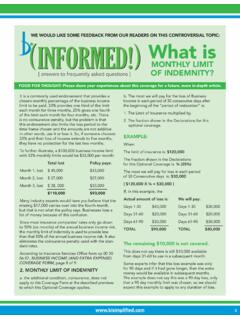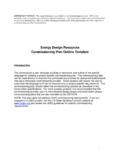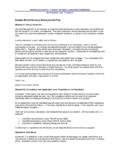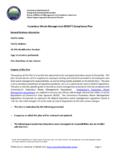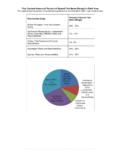Transcription of CONTINGENCY PLAN OUTLINE
1 CONTINGENCY PLANNING. Business Income insurance is the most complicated and misunderstood form of insurance, resulting in misconceptions and wrong decisions that cost businesses a lot of money and some people their jobs. Clearly, most businesses do not know how to calculate their needs resulting in over 70% of them going out of business after a major loss. At the same time, the other 30% never quite fully recover, as they are always playing catch-up with the marketplace. Most executives rely on their financial statements for planning and financing activities, but these are not the correct numbers when it comes to insurance values or loss recovery. As complex as this issue may appear, a systematic approach will guarantee that the right kind of insurance is purchased for the correct amount of coverage.
2 A Business CONTINGENCY plan also ensures that alternative actions and resources are identified and everyone in the organization is aware of their responsibilities. This approach is essential to a smooth recovery, making sure adequate resources are available. The first stage would be to review the disaster recovery planning process because this impacts the calculation of both the business income limit (how long it takes to recover the business) and the extra expense limit (the amount of extra financing you need to recover immediately). Next, review the insurance coverages because they directly impact what and how much of the loss will be paid. You will not know how much financing you require until you understand how the contract will respond.
3 Otherwise, it is like asking a bank for a loan without knowing how much you really need. Finally, calculate how much income the business will lose and how much extra expense will be needed to recover as quickly as possible. Risk management and business continuation planning are critical components of a competitive strategy. Contrary to popular belief, disasters do happen, and they do not always happen to the other person. Organizations need a business CONTINGENCY plan for protection of market share and brand reputation, regulatory compliance, maintenance of cash flow, protection of vital records, protection of assets and employees, and the survival of the company. Companies don't plan to fail, they fail to plan ! Most organizations do not have a fully tested CONTINGENCY plan , jeopardizing their assets and their employees' lives.
4 The business CONTINGENCY plan is the survival document that determines what needs to be done and who is responsible for implementation. Strategic plans include response to permanent total/permanent partial damage, or temporary total/. temporary partial damage, as well as hot work issues (continuing to operate while repairs are ongoing). We suggest Internal Audit be involved and responsible for overseeing the plan . Determining the disaster recovery period directly impacts how much financing (insurance) a company will need in order to rebuild their business after a disaster. The CONTINGENCY plan identifies the continuing expenses and lost profit (business income), as well as the extra dollars (extra expenses) that are needed to carry the company through the recovery period.
5 This recovery time is measured from awareness of the disaster/event, to the time it takes for the organization's revenues to reach their projected level had there been no loss. Without a plan , an organization does not know what to do or where to go after a disaster. Time and resources are wasted tying to recover the business instead of creating a more efficient operation. The CONTINGENCY plan is an opportunity document that allows the organization to look at all phases of the operation and use the recovery as the time (based upon a cost/benefit analysis) to eliminate low margin products, flatten the organization, and increase productivity. The result is to reform the organization into a more efficient operation, competitively ready to do business into the next decade.
6 The key components of the CONTINGENCY plan are developing a strategy, assessing the impact of various catastrophe scenarios on the organization, protecting employees, assigning specific CONTINGENCY responsibilities to teams with the appropriate expertise, and finally, testing, testing, testing. Develop a CONTINGENCY plan that makes the disaster transparent to the marketplace, one that will reduce the recovery time and allow you to stay in business while the property is being restored. Then purchase sufficient business income insurance or secure other financing for the full time frame of recovery. Keep in mind that business income insurance policies generally do not pay for the rebuilding of inventory. Use the inventory coverage on your commercial property policy.
7 Do not forget that the plan also includes the community's response capabilities. When testing your plan , include the emergency management system (police, firefighters, hospital, and ambulance) so they may also rehearse their response plans. The easiest way to develop a business CONTINGENCY plan is to separate it into its different components. The CONTINGENCY Coordinator, who heads CONTINGENCY planning committee, is appointed by the chairman or president with the committee consisting of the senior managers responsible for such areas as operations, legal, sales, administration, etc. It is the responsibility of this group to OUTLINE the strategic plan and to supervise the development and testing of the company's CONTINGENCY plan . We suggest Internal Audit monitor the plan 's overall progress throughout the organization and report to the committee.
8 A business impact analysis is completed to identify bottlenecks and the most serious threats to the organization. Functional unit managers are required to complete the business impact analysis for their area. They are also responsible for reducing risk and implementing operating efficiencies, establishing necessary back-ups, and eliminating unnecessary redundancies. Additionally, they should identify outside resources that could be helpful at the time of a disaster and establish interactivity with them. Next, to protect employees and visitors, life safety procedures should be implemented and practiced. CONTINGENCY teams and their responsibilities are identified, staffed, and supplied. The plan is tested, tested, tested. STRATEGIC PLANNING is the general OUTLINE of what actions the company will take should a disaster occur.
9 Base the length of recovery time on the worst possible loss that could occur and consider seasonality, as well as new and renewal business. For example, if a Christmas ornament manufacturer has a disaster in July that takes a year to recover, not only may they lose the current season, but the next one as well. That is two years of sales enough to bankrupt most companies. Determine how long the marketplace will allow you to be nonfunctional before you start losing business. This is your Return Time Objective and it dictates all the other components of your plan . For example, if you are the only business selling your product or service, customers will wait forever and you will have time to recover. On the other hand, if there are a large number of suppliers for your product or service, you may only have three or four weeks to get back into the market, so it is critical to have a well- developed CONTINGENCY plan .
10 Ascertain how much data you could afford to lose. This is your Return Point Objective and will determine your back-up policies. For example, if you can lose one week's data, why back-up every night? On the other hand, if you cannot afford to lose one day's data, why back-up only once a week? Also, do not store back-up data in the same building where you operate. Store it at least 25 miles away. Review your storage facilities. Do you have a separate warehouse? After the disaster, how much undamaged inventory will you have on hand or in the marketplace? Could you stuff the pipeline and redistribute inventory after the disaster? For example, if you have one month's inventory on hand, you might have one month to recover before you start losing sales.

